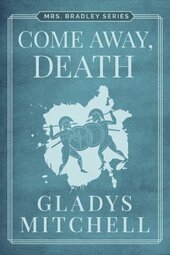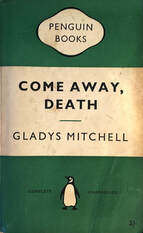Come Away, Death finds Mrs. Bradley on a tour through the temple ruins of ancient Greece, where guide Sir Rudri Hopkinson is eager to recreate the Mysteries of Eleusis, rituals designed to appease and invoke the Hellenic gods.
Mitchell scholar and academic archaeologist Nick Fuller provided me with a lot of great information on the Mysteries and their actions. This is what the dogmatic Sir Rudri attempts to recreate, and I offer up Nick's research here (with more to come in future installments):
THE ELEUSIAN MYSTERIES
There are two sets: the Lesser Mysteries (an annual ceremony, involving purification) and the Greater Mysteries (held every four years). The participants are referred to as mystae and are initiated into the cult of Demeter and Persephone.
Greater Mysteries – Sequence of events (based on https://en.wikipedia.org/wiki/Sacred_Way)
- Day one: Initiates gather in Agora (Athenian marketplace); fast; parade to the Eleusinion (sacred precinct of Demeter)
- Day two: Ritual cleansing in Bay of Phaleron
- Day three: Initiates sacrifice a suckling pig
- Day four: Cults of Asklepios (Latin, Aesculapius, god of medicine) and Hygieia (goddess of health) join celebrations in Athens; god visits initiates in dreams. (Mitchell's tour group visits Asklepios' centre at Epidaurus, one of the great hospitals of ancient Greece.)
- Day five: Procession along Sacred Way from Athens to Eleusis; visit temple precinct at Daphni
- Day six: Pannychis - women with torches dance by night
- Day seven and eight: Visit Demeter's temple at Eleusis; myth of Demeter and Persephone enacted; initiates receive sacred vision; priest holds up a grain of seed reaped in silence
- Day nine: Initiates return home
FIRST IMPRESSIONS

Rock Shop Mysteries author Catherine Dilts was also back for a second Mrs. Bradley outing, after being introduced to GM and her detective in the last group reading event. She writes, "I love the story so far. Unlike the previous read, Mystery of a Butcher's Shop, we don't yet have a body by the end of Chapter Five. There are strong hints that amateur archaeologist Sir Rudri Hopkinson and his rival Alexander Currie are angry enough to - possibly - kill one another. And some deserve to die, like the photographer Armstrong, who is prone to kicking children. I am happy to ride along with the tour for now, as I try to follow the hints and clues dropped along the way for what I assume will happen soon."
JF Norris of Pretty Sinister Books is not enjoying the pageant thus far. I will present his chief complaint soon, but this is his reaction to the opening chapters: "I'm not intrigued by any of this. I don't know which characters to side with, everyone seems arrogant, stupid, flighty or selfish. This better improve and become something resembling a detective novel instead of an odd fantastical travelogue with mythological allusions."
JF continues, "I don't know what to make of this one frankly. It's clearly meant to be a send-up of something. I thought maybe she was sticking it to her fellow Detection Club member Agatha Christie, who had just published Murder in Mesopotamia in 1936. Mitchell's book comes so close on the heels of Christie's detective novel that I'll have to admit that it is probably not a response to the Grand Dame's archeological murder mystery. But the two books have a quite a lot in common."
Martyn Hobbs was impressed by the evocative brevity of the prose and the allusion in the title: “There’s something rotten in the isles of Greece. In three well-wrought paragraphs made up of only four sentences (eat your heart out, Henry James), Gladys Mitchell gives us a whiff of the modern human-engendered pollution that has come to the Greece of Homer, Sappho and Aristophanes; and pollution, whether physical or moral, was no laughing matter for the Ancient Greeks.
“And then there’s the title, which comes from a song in Twelfth Night:
Come away, come away, death,
And in sad cypress let me be laid.
Fly away, fly away, breath;
I am slain by a fair cruel maid.
“There are plenty of cypresses in Greece under which corpses can be laid. It doesn’t augur well.”
THE SIGHTS AND SOUNDS AND LACK OF A CORPSE
‘She stood before the Stele of Aristion, contemplating, not only the greaved and kilted warrior with his curled locks and long, straight feet, but the imaginary spectacles of Sir Rudri walking with torches in the dusk of the Greek evening, chanting strange hymns and sorrowful litanies to the Eleusinian gods Iacchus and Dionysus, and to the god-king Triptolemus. She could see him, dogged idealist and romancer, proceeding ploddingly the while along the petrol-haunted, dusty Sacred Way which now led, in the age of progress, the world no longer young, from one Greek slum to another.’
But it’s also true that, certainly in the first five chapters of Come Away, Death, Gladys Mitchell breaks the unwritten genre rule that a murder has to occur early to get the plotline started. Sacrilege or mere playing with form? It depends what experience you’re looking for. While I remembered the dry and dusty atmosphere of this book from my long-ago prior reading, I was surprised that the sacrificial victim (for story’s sake) had not yet arrived by the end of this section. What I tracked instead – to my enjoyment – was the mounting acrimony and incident between the travellers, and how secrets and grudges are revealed one at a time.
JF was frustrated with this breach of convention as he continues to ask: “Where’s the murder?” The characters also fall short here for him, and he writes that “the two squabbling antiquarians seem more like children than the trio of boys who want nothing more than to play pranks. Mrs. Bradley is relegated to a sort of nanny/babysitter/pal to the boys. At least they all get decent lodging when she insists they get decent beds at a hotel in Athens. When Cathleen is forced to reveal her secret marriage, Mrs. Bradley becomes an advice giver even if that advice amounts to absolutely nothing. This is like an anti-action set of chapters.”
THE BOYS
Catherine had a different view, and suggested a way to cope with the vernacular: "I have decided a new drinking game can be based on Come Away, Death. Every time one of the boys says the word 'ass' [as in 'you ass'], one is required to take a shot. That being said, I love how Mitchell captures the boys' personalities."
FINAL THOUGHTS ON CHAPTERS 1-5
Catherine Dilts: "I like Mrs. Bradley better in this novel. Looking forward to hearing more of her adventures." (Catherine is listening to the audiobook during a month with much commuting.)
JF Norris: "Four chapters of exposition, three pranks to mystify and antagonize Sir Rudri, a quasi-mystery of who is pretending to be a living statue... Sigh... But where's the murder?"
Martyn Hobbs: "Gladys Mitchell must have been a glorious teacher. Mrs. Bradley demonstrates great sympathy and understanding for the boys in her charge, not least when she entertains them with her tales of the ex-convent executioner!"

Back next week for Chapters Six through Ten! Send observations to [email protected] and I will incorporate them into the post.
 RSS Feed
RSS Feed